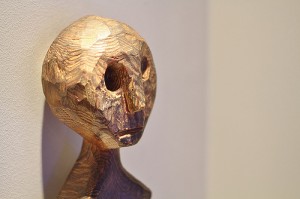Yesterday we discussed Nocebo responses, such as what happens when someone feels that they’ve been cursed or given a medical death sentence. But how can a feeling, a belief, cause your death? Surely that isn’t actually possible?
Unfortunately it seems that it is. While it is difficult to study nocebo responses, as most ethical boards look down on trying to cause harmful reactions in your subjects, brain scanning technology and experiments have shown a couple of interesting correlations between nocebo responses and brain activity.
A study by Jon-Kar Zubieta of the University of Michigan, Ann Arbor used PET scans to show that nocebo effects were linked “with a decrease in dopamine and opioid activity” which would help explain why nocebo responses could cause increased pain. In 1981, Wylie Vale discovered corticotrophin, the brain’s hypothalamic stress hormone. When coordinated with the brain stem adrenaline centers this hormone can cause a massive release of adrenaline-like nerve chemicals and stress hormones. Vale concluded that, “Together these might well cause illness, including loss of appetite, weakness, cardiac arrhythmias, and even vascular collapse that could result in death.”
Looking into traditional stories of individuals fainting away from fright provides another explanation. Called vasovagal responses or syncope, it is one of the most common causes of fainting. These responses are triggered by a wide variety of conditions, and are incredibly individualized. Typical triggers include stress, standing up very quickly, fear, and unpleasant or painful stimuli like watching medical procedures or the sight of blood. Such a response involves fainting, as well as possibly nausea, feeling extremely hot or cold, ringing in the ears, an inability to speak/form words, as well as nervousness.
This all stems from a malfunction in the parts of the nervous system that regulate heart rate and blood pressure and in extreme cases can cause permanent damage- especially when combined with other factors.
Given that death, discomfort, and injury are real possibilities when it comes to nocebo responses, it is necessary to take care to avoid situations that trigger them. However, given the very nature of fear and stress, it is difficult to determine what causes a nocebo response. What makes one person get better from a sugar pill while another individual can swallow 26 of them in an attempted suicide andrequire injections of fluids to be stabilized?
Studies show a wide variety of causes, from color of pills to the way that medical consent forms are worded. But perhaps some of the most common causes are the hardest to control: rumor and perception. In the New Zealand example we used yesterday subsequent tests showed that reports of negative side effects most closely matched areas that had media outlets reporting on the drug’s perceived side effects. In Tokyo after the 1995 Aum Shrinrikyo sarin nerve-gas attack hospitals were flooded with patients who were convinced that they had the highly publicized potential symptoms of nausea and dizziness, even though they had not been exposed.
Perception, meanwhile, plays a large part in how patients respond to medical personnel and in research studies. A simple wording change can affect how people respond to a vaccination or treatment, saying “the great majority of patients tolerate this treatment very well” versus saying “some patients experience mild side effects to this treatment” has been shown to lower the number of adverse events experienced- even though the two phrases are essentially the same.
Studies on verbal and non-verbal communications of medical staff show that patients are highly receptive to negative suggestion. One experiment illustrated that the more often words like “sting,” “burn,” “hurt,” and “pain” were used before doctors injected radiographic substances, the more pain patients reported.
At the same time patients who are told about potential negative side effects were much more likely to experience them. Of a group of men taking Finasteride, a treatment for enlarged prostrates and hair growth, one group was told about the possibility of erectile dysfunction, ejaculation problems, or decreased libido while on the drug, while the other was not. Of the group that was not informed 15.3% reported sexual side effects. Of the group that was informed, 43% reported adverse side effects.
Unfortunately, given that simply discussing negative possibilities can cause patients to experience them, doctors are at a bit of an impasse. Do they warn patients about pain so that they can expect it, or do they not? Do they discuss possible negative side effects or simply mention that there are side effects?
It’s a tough call to make. However, there are some signs that some people are more prone to nocebo effects than others. Generally people in extreme situations (like terrorist attacks) are in a natural trance state and thus highly suggestible. In most situations of mass hysteria, however, it looks as if people under a higher level of stress are more likely to experience nocebo effects or mass hysteria. People who feel as if they have little control, who are not financially stable, who have had less sleep or who are less likely to trust their superiors or supervisors are more likely to be affected.
At the same time, it tends to be nebulous effects that are more likely to be the result of a nocebo response. Very rarely to people break out in rashes or bleed from the eyes in a psychosomatic response. More likely the responses seem to center around problems in breathing, nausea, disorientation, or an increase in pain.
Such vague complaints can easily turn into a vicious cycle. People who have a history of vague, difficult-to-diagnose complaints tend to be sure that there is nothing that can be done to fix their problems, and they tend to be proven correct.
Even more interesting, however, is that what causes a negative reaction in one person may not in another. In an Italian study, for example, blue placebos were ineffective in being used as sleeping pills for men, but worked for women. Why? Because the Italian national football team’s color is azzurri blue.
Meanwhile it’s been found that certain groups of Chinese Americans die younger than expected- mainly those that have a disease that is astrologically linked negatively to their birth year. Those Chinese Americans who were born in a year linked to poor heart health, for example, would die on average of five years earlier from heart-related diseases than someone born in some other year with the same disease. But this correlation was only visible for those people who were strongly committed to traditional Chinese culture. Non-believers in the same situations would not experience the same effects.
Besides individual deaths and misfortune, however, there is a societal cost to nocebo responses. Not only do such responses undermine the efficacy of drugs like vaccines, causing more individuals to resist taking them, but they also contaminate research trials for new treatments. This is all on top of the basic cost of drug side effects, which cost the U.S. health system more than $76 billion a year, according to a 1995 University of Arizona study.
So what do you do? In the end, perhaps the best takeaway for most individuals is simply the knowledge that nocebos exist. Being aware that emotion and general opinion has an effect on how your body reacts is a great way to quell rising panic, and to hopefully push individuals towards a positive recovery.
And when a co-worker tells you about the secret curse that haunts everyone who eats lunch on the outside stairwell, perhaps take it with a grain of salt.





